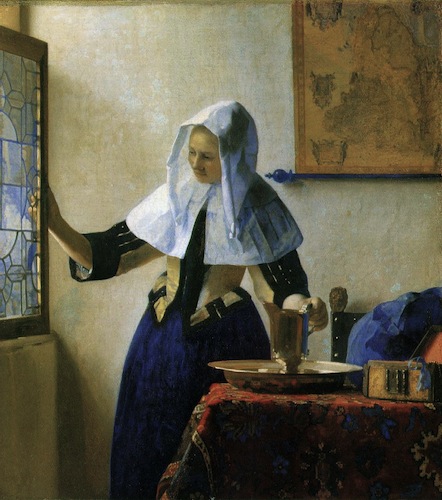When I was at university I overheard a conversation when someone said:
I just don’t understand how you can say you like both the Pre-Raphaelites and Vermeer.
It has stuck with me ever since. It’s just a perfect one-line bit of art criticism. It always seemed like it ought to make a great parlour game†: ‘I just don’t understand how you can say you like both x and y… fill in the blanks.’ But actually I’ve never been able to find a pair which seems as perfect as Vermeer and the Pre-Raphs.

Vermeer basically painted accurate pictures of his own time and place; carefully composed, tidied up and idealised, perhaps, but realistic, small scale, domestic. The Pre-Raphaelites‡ chose to retire to a silly fantasy world of knights and maidens which avoided the difficult complex reality of the nineteenth century — but avoided the difficult complex reality of the medieval world as well.
And Vermeer is sensual but austere; sensual in his representation of surfaces, textures, light and shadow, but stylistically austere in his classically perfect compositions and controlled, precise brushwork. While the Pre-Raphaelites are the opposite: stylistically they are lush and decorative, but the result is bloodless. Their paintings are full of decorative young men and women posturing and looking glamorous, but it’s all surface. There’s no flesh to it, not a whiff of filth.
In one of Aldous Huxley’s early novels, which are satirical portraits of London bohemia, there’s a character called Casimir Lypiatt who sees himself in the Renaissance tradition of painter-poet-thinkers, full of bombastic rhetoric about Art and Beauty and moral significance. Not everyone is as impressed with him as he is:
‘Number seventeen,’ said Mrs Viveash, ‘is called “Woman on a Cosmic Background.”’ A female figure stood leaning against a pillar on a hilltop, and beyond was a blue night with stars. ‘Underneath is written: “For one at least, she is more than the starry universe.”’ Mrs Viveash remembered that Lypiatt had once said very much that sort of thing to her. ‘So many of Casimir’s things remind me,’ she said, ‘of those Italian vermouth advertisements. You know – Cinzano, Bonomelli and all those. I wish they didn’t. This woman in white with her head in the Great Bear….’ She shook her head. ‘Poor Casimir.’
Presumably Huxley, writing in 1923, was not thinking of the pre-Raphaelites. But that description is brutally spot on.

Vermeer took the small and mundane and made it something hypnotic; the Pre-Raphaelites took a grand mixture of ideas, ideals, myth and history, and made a lot of pretty posters.
* OK, maybe ‘hate’ is a bit strong. But, you know, linkbait innit.
† Actually, thinking about it, a truly dreadful parlour game. A mildly interesting intellectual exercise, maybe.
‡ Yes, I know, I’m lumping them all together in a rather lazy way. But although the exact details varied from painter to painter, and some were better than others, I think the broad argument applies to all of them.
7 replies on “Why I hate the Pre-Raphaelites*”
What about Ford Maddox Brown? He painted contemporary, social realistic stuff. Also William Holman Hunt used antique imagery to make psychological points.
I’m not a particular fan of either of those two, but I certainly find Ford Madox Brown’s paintings of contemporary subjects a lot less annoying and more interesting than the archetypal Pre‑Raphaelite stuff. Holman Hunt I have less time for, whatever he’s painting.
The argument is a bit simplistic, I’ll admit, especially given the number of different artists involved. Whether what’s really bothering me is a purely Pre‑Raphaelite thing, or a Victorian thing, or even a broader idea of a kind of fantasy sensibility… to tease out all the nuances properly would take a whole book rather than a blog post. If I managed to articulate them at all.
Blog post or not, it’s still a place for criticism, and responses such as these. I’m happy people are at least writing about art and know some of the names.
Thanks :-)
I like very much what you say about Vermeer. The sensuality with which he translated surfaces into 2D is almost painfully pleasurable.
To my knowledge Ford Madox Brown was the only pre-raph who created anything of any substance and insulted by his inclusion in the group. The rest, to my knowledge, produced vapid nonsense. The main body of work seems to lie still born on the support. I understand the foolish truism that something so hated must have something to it. Here it really is just rubbish and dangerous rubbish because it is rallying point for the philistines who are dangerous because feel themselves aesthetes. It makes me think of Una Stubbs cooing over that other bit popular philistinism, that wretched late Dali crucifixion.
Oh well, ‘dangerous’ might be bit strong. But I’m glad you liked the post.
the Pre-Raphs were the Patrick Nagel of their day.